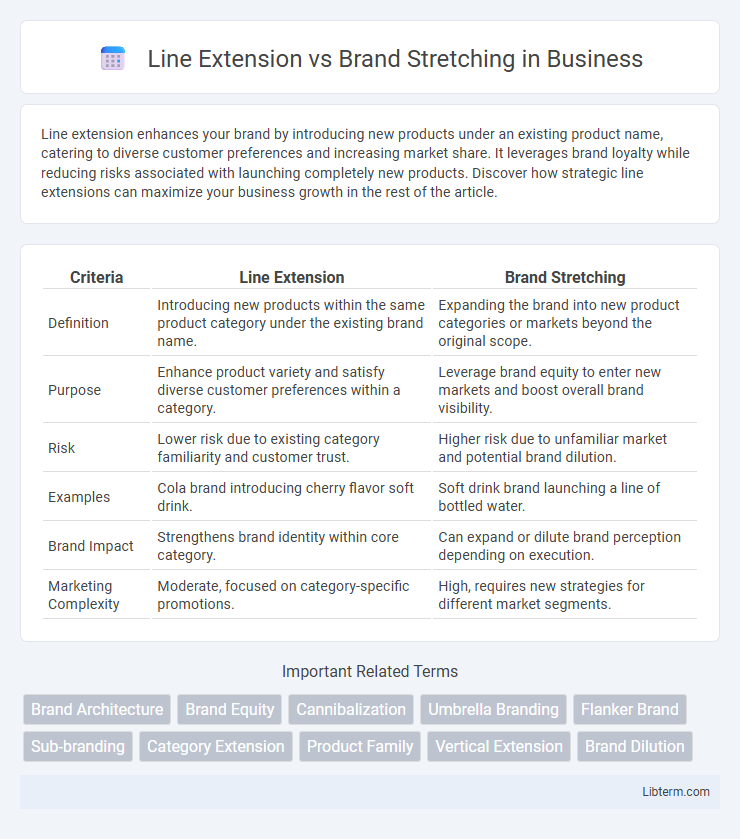Line extension enhances your brand by introducing new products under an existing product name, catering to diverse customer preferences and increasing market share. It leverages brand loyalty while reducing risks associated with launching completely new products. Discover how strategic line extensions can maximize your business growth in the rest of the article.
Table of Comparison
| Criteria | Line Extension | Brand Stretching |
|---|---|---|
| Definition | Introducing new products within the same product category under the existing brand name. | Expanding the brand into new product categories or markets beyond the original scope. |
| Purpose | Enhance product variety and satisfy diverse customer preferences within a category. | Leverage brand equity to enter new markets and boost overall brand visibility. |
| Risk | Lower risk due to existing category familiarity and customer trust. | Higher risk due to unfamiliar market and potential brand dilution. |
| Examples | Cola brand introducing cherry flavor soft drink. | Soft drink brand launching a line of bottled water. |
| Brand Impact | Strengthens brand identity within core category. | Can expand or dilute brand perception depending on execution. |
| Marketing Complexity | Moderate, focused on category-specific promotions. | High, requires new strategies for different market segments. |
Understanding Line Extension and Brand Stretching
Line extension involves introducing new products within the same category under an existing brand name, such as different flavors or sizes, to leverage brand loyalty and increase market share. Brand stretching, or brand extension, expands a brand into entirely new product categories, aiming to capitalize on brand equity and enter new markets. Both strategies utilize established brand recognition but vary in risk and impact on brand identity depending on product relevance and consumer perception.
Key Differences Between Line Extension and Brand Stretching
Line extension involves introducing new products within the same product category under an existing brand name, leveraging existing customer loyalty and brand recognition. Brand stretching expands the brand into entirely different product categories, aiming to utilize brand equity to capture new markets but with higher risk of brand dilution. Key differences include product category scope, consumer perception, and strategic risk associated with each approach.
Benefits of Line Extension Strategies
Line extension strategies enhance brand presence by introducing new variations of existing products, catering to diverse consumer preferences without the cost of launching an entirely new brand. This approach leverages established brand equity, increasing consumer trust and purchase likelihood while optimizing marketing efficiency. Expanding product lines through line extensions also boosts shelf space and retailer support, contributing to increased market share and revenue growth.
Advantages of Brand Stretching for Brand Growth
Brand stretching leverages an established brand name to introduce new products in different categories, significantly enhancing market reach and consumer trust. This strategy reduces marketing costs and accelerates product acceptance by capitalizing on existing brand equity. Expanding into diverse markets through brand stretching fosters long-term brand growth and increases overall competitive advantage.
Risks and Challenges of Line Extension
Line extension carries risks such as brand dilution, where introducing too many variations may confuse consumers and weaken the core brand identity. It can also lead to cannibalization, decreasing sales of the original product by diverting customers to new versions. Managing production costs and maintaining consistent quality across extended lines pose significant operational challenges.
Potential Pitfalls of Brand Stretching
Brand stretching risks diluting the original brand identity, causing consumer confusion and weakening brand equity. Inappropriate brand extensions may fail to align with core brand values, resulting in negative perceptions and reduced customer loyalty. Financial losses and damaged reputations often follow unsuccessful stretching into unrelated product categories.
Successful Examples of Line Extension
Successful examples of line extension, such as Coca-Cola introducing Diet Coke and Apple launching the iPhone SE, demonstrate how brands can effectively leverage their existing reputation to enter adjacent markets while maintaining customer loyalty. Line extensions capitalize on the parent brand's equity by offering variations of existing products that meet specific consumer preferences, reducing the risks associated with new product launches. This strategy enhances market penetration and revenue growth without diluting the core brand identity, distinguishing it from broader brand stretching efforts.
Notable Cases of Effective Brand Stretching
Apple's extension from computers to consumer electronics like the iPhone showcases effective brand stretching by maintaining a strong identity rooted in innovation and user experience. Virgin Group's expansion across diverse sectors such as airlines, music, and telecommunications leverages the brand's core values of adventure and customer service. Samsung's transition from electronics to home appliances and medical devices exemplifies brand stretching through consistent technological excellence and innovation.
When to Choose Line Extension Over Brand Stretching
Line extension is ideal when a company aims to enhance its existing product category by introducing new variations, flavors, or features that appeal to current customers without altering the core brand identity. Choose line extension when market research indicates strong brand loyalty and demand for more options within the same product line, ensuring minimal risk and leveraging established brand equity. Brand stretching should be reserved for entering entirely new markets or categories where the brand's reputation can support diverse applications beyond its original scope.
Best Practices for Implementing Line Extension and Brand Stretching
Effective line extension involves maintaining consistent brand identity while introducing variations that meet specific customer needs, such as new flavors or sizes, ensuring product quality remains high to prevent brand dilution. Brand stretching requires careful market research to align new product categories with the core brand values, leveraging existing brand equity to build trust in unfamiliar segments without confusing consumers. Both strategies benefit from clear communication, targeted marketing campaigns, and monitoring consumer feedback to adapt and sustain brand loyalty.
Line Extension Infographic

 libterm.com
libterm.com